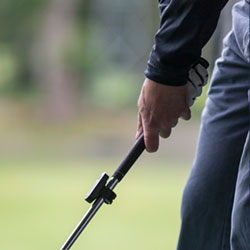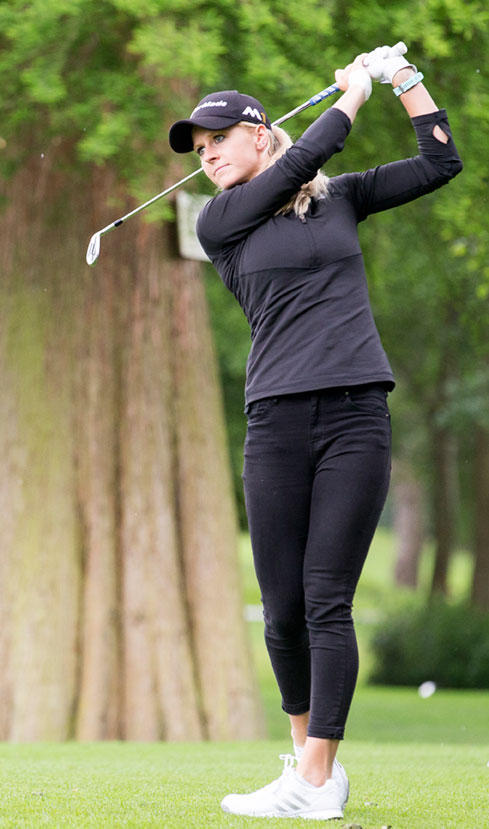
Technology has provided golf pros with the chance to add new elements to their teaching. GOLF RETAILING went to a Garmin press day at Silvermere to view their new range and find out exactly how they can benefit pros.
Technology is developing at such a fast rate that the products which were cutting-edge only a few years ago now look out of date and, in the golf sector, this technology has often been used for DMDs and coaching aids. Garmin first entered the DMD category in 2010 and launched the first golf GPS watch in October that year; it’s fair to say that the sector has developed a considerable amount since then.
For golf pros technology can be incorporated into coaching to help get their message across to their students; it is often easier for someone to pick up a skill if they have visual information in front of them and can see exactly what they are doing wrong. The TruSwing clips onto a club and gives a range of information, such as swing tempo, speed, club-path measurements, critical club angles and more alongside a visual representation of the swing.
A problem with all forms of technology is understanding and evaluating the data that is produced, something which often requires a good degree of knowledge. It is for this reason that Garmin are keen for golf professionals to use TruSwing with their clients as they will be able to help them evaluate the data correctly.
Steve Rastall, PGA Pro at Silvermere, uses the TruSwing with clients and comments, “Using this technology really helps clients to see what they are doing with their swing. If I tell you that you are rolling your wrists it can be hard for someone to know what I am talking about, but with this they can see what it means for their shots. What’s good as well is if a client has a TruSwing then they can show me the data from when they went to the range or played and then I know what they have been doing and what we need to work on. It takes the guess work out of it.”
Rastall also comments that he finds it useful to compare the data for a client’s good and bad shots together to see exactly what is different and that he also sends clients screenshots of examples of what he wants them to work on before the next lesson. There’s a host of different technological coaching options open to golf pros and if they pick the right one it can add a different element to their lessons and be a new way of engaging with clients.
Ladies European Tour Pro Iona Stephen on getting down to a four handicap 18 months after picking up a club for the first time and how she uses technology to help her game
When did you first pick up a club?
I was 20, just about to turn 21, and I was instantly hooked. As soon as I could I went to put three cards in and get my handicap – my first one was 19 and within 18 months I had got my handicap down to four and was playing for my county. I had such a hunger to improve and hitting the ball came naturally, it was just about getting more consistent and working on my short game. I’ve become a real student of the game to try and improve quicker.
Has playing on Tour been an ambition from when you first picked up a club?
Yes, I’ve always wanted to be a professional athlete. Within 18 months my handicap was four but then there’s a big jump to go from that to scratch and it took me around a year to do this, but before I turned professional I got my handicap to plus three. I worked with a coach at Wentworth called Kristian Baker who played a big role in this and I broke a few course records along the way as an amateur which was great, but getting onto the Tour was always my goal. To get down from four to scratch involved two main things: making the bad shots better and having the confidence to finish off – when you are a few under par after nine holes you need the mental strength to keep playing good shots.
What data do you obsess about?
From a technical point of view, club path and face are the most important. Club path is one that has had a big impact on how I am playing at certain times – around 14 months ago my club path had a tendency to be from out to in and that was having a big impact on my natural ball flight so I worked hard on getting that as close to neutral as possible. Distance control, knowing the numbers that you hit certain clubs, is also really important – we always work to carry yardage as opposed to total yardage; as long as you know how far the ball is going to land you get some control over your game. Club head speed is another number I take notice of to make sure that the clubs I have are right for me, as if they are too heavy that can influence club head speed. I do a lot of training off the course so it’s great to to see what impact that’s had on my swing.
Who is your coach and what’s your relationship?
Brian Evans, director of golf at Qunita do Lago Portugal – he tries to help me achieve as natural a swing as possible and his explanation around the swing is incredibly clear and has allowed me to have more freedom around my game. At the moment we are making sure that my body is dynamic and I don’t get too static as I initially thought that was what was needed for golf. As an amateur I worked with lots of different coaches and that was great as it allowed me to think about exactly what it is that I’m looking for in a coach as coaches are very different; some like to work with a lot of data, some with videos and some with neither.
How have Garmin products helped you?
With the products I am getting live information about my game and how I am improving – it would be difficult to know how I am doing just based on feel. The software is critical in assessing my performance and if I’m not improving it gives me the information to know what I need to work on. I feel very lucky to be working with such a great brand and equipment. I was using TruSwing and working with Brian to try and find a driver that would maximise my distance and accuracy off the tee; my distance was good but I was sometimes losing them to the left. We got a few different shafts from TaylorMade and clipped them onto the M2 head and, using the TruSwing, we were able to get data which showed the way I was swinging the club. I am now playing with a three wood shaft clipped onto my driver head as the TruSwing showed that I was getting increased club head speed. It felt like that, but you don’t know for sure until you have factual data so we went onto the course with different shafts and the three wood one performed best for me, so that is now in the bag.








